Remembering the Rosemary Neighborhood by Knopf & Near
Sunday, August 15th, 2021David Penniman, a resident of the Rosemary neighborhood, sleuthed out a copy of a document penned in 1984-88 by Richard C Knopf and Miriam F Near. The document, entitled Reminiscences: Not Memoirs, is a free-wheeling remembrance of growing up in the neighborhood around Henderson and Rosemary Parkway in the 1920s, 1930s, and 1940s. Dave’s copy came from Ann and Keith Bossard of Dominion Blvd; Dave then digitized the 97 page book and shared it with us. Thanks, Dave!
Both Richard and Miriam are deceased; their obituaries are linked below.
Richard C Knopf, 1/4/1925 – 7/17/2002
Miriam Fowle Near, 6/28/1924 – 12/10/2009
I’m so appreciative of people who preserve local history, as Richard and Miriam, and Dave, have done.
[Digital version of the Knopf and Near typescript courtesy of David Penniman. Knopf obituary came courtesy of the Ashtabula Public Library System based on a search and tip from Nick Taggart, retired librarian par excellence at the Columbus Metropolitan Library.]

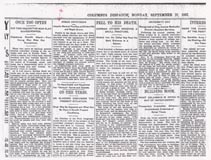

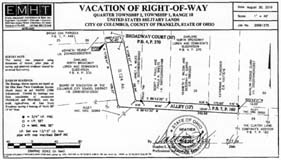

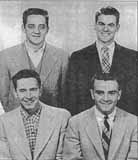
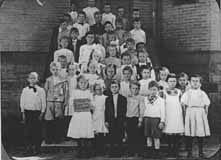
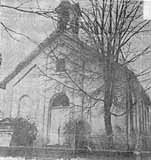 In 1842, Clinton Township School District 1 acquired land at Henderson and High Street from Chauncey Cooke, and in 1878, built a brick school building on the southwest corner. The building was used both as a school and for worship services by various denominations. In 1920, the district deeded the school to the Methodist Church, and the Maple Grove Methodist Episcopal Church was organized. It was at the time the only church between Clintonville and Worthington. (Photo courtesy of the Ron Ohsner family)
In 1842, Clinton Township School District 1 acquired land at Henderson and High Street from Chauncey Cooke, and in 1878, built a brick school building on the southwest corner. The building was used both as a school and for worship services by various denominations. In 1920, the district deeded the school to the Methodist Church, and the Maple Grove Methodist Episcopal Church was organized. It was at the time the only church between Clintonville and Worthington. (Photo courtesy of the Ron Ohsner family)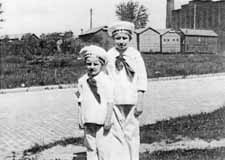 We tend to think of the use of prefabricated buildings for temporary quarters a new idea, but it seems to be as old as our township schools. I have found pictures of old World War I military barracks, and also portable voting booths, used for schools all over Clintonville. Our Lady of Peace used both types of buildings. Glenmont Elementary School began life as a cluster of portable schools. Clinton Elementary School handled overcrowding with temporary buildings. Shown here are some portable voting booths at the old tile factory along Arcadia (where North High School presently stands). (Photo courtesy of Wallie Palmer)
We tend to think of the use of prefabricated buildings for temporary quarters a new idea, but it seems to be as old as our township schools. I have found pictures of old World War I military barracks, and also portable voting booths, used for schools all over Clintonville. Our Lady of Peace used both types of buildings. Glenmont Elementary School began life as a cluster of portable schools. Clinton Elementary School handled overcrowding with temporary buildings. Shown here are some portable voting booths at the old tile factory along Arcadia (where North High School presently stands). (Photo courtesy of Wallie Palmer)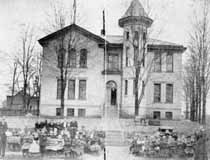 I would love to find a photograph of the original school at Clinton Heights and North High Street. According to one or two accounts, a Brevoort family member living in Michigan has one. The school pictured here ca. 1905 was the second Clinton Heights school building. It was yellow brick, contained 4 rooms, and faced High Street. Since students attended from all over Clinton Township in those days, many rode horses to school; the barn at the back was probably used for horses. According to the photo caption, most of the school moved into High Street for the picture. An interurban rail went up the center of High Street at the time, and the photographer probably stood on the tracks to take this picture. (Photo courtesy of Amy Westervelt)
I would love to find a photograph of the original school at Clinton Heights and North High Street. According to one or two accounts, a Brevoort family member living in Michigan has one. The school pictured here ca. 1905 was the second Clinton Heights school building. It was yellow brick, contained 4 rooms, and faced High Street. Since students attended from all over Clinton Township in those days, many rode horses to school; the barn at the back was probably used for horses. According to the photo caption, most of the school moved into High Street for the picture. An interurban rail went up the center of High Street at the time, and the photographer probably stood on the tracks to take this picture. (Photo courtesy of Amy Westervelt)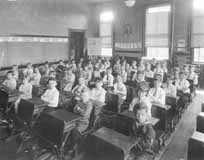 This is a picture of children in the classroom of the Clinton Heights school. (Photo courtesy of Amy Westervelt)
This is a picture of children in the classroom of the Clinton Heights school. (Photo courtesy of Amy Westervelt)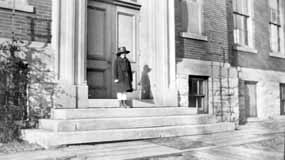 The second Clinton School was built in 1895 at 10 Clinton Heights Avenue. At the time, it housed both a grammar school and a high school. In 1904, the Clinton Township High School Building was built (pictured); it remains today as the Clinton Elementary East Building. A successor to the original building—still used–was built in 1922. (Photo courtesy of Amy Westervelt)
The second Clinton School was built in 1895 at 10 Clinton Heights Avenue. At the time, it housed both a grammar school and a high school. In 1904, the Clinton Township High School Building was built (pictured); it remains today as the Clinton Elementary East Building. A successor to the original building—still used–was built in 1922. (Photo courtesy of Amy Westervelt)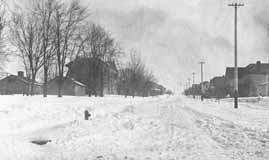 Overcrowding has been a chronic problem for schools. This photograph, looking east up Clinton Heights Avenue, shows some of the portable school buildings that were used as classrooms until newer school buildings could be erected. (Photo courtesy of Amy Westervelt)
Overcrowding has been a chronic problem for schools. This photograph, looking east up Clinton Heights Avenue, shows some of the portable school buildings that were used as classrooms until newer school buildings could be erected. (Photo courtesy of Amy Westervelt)